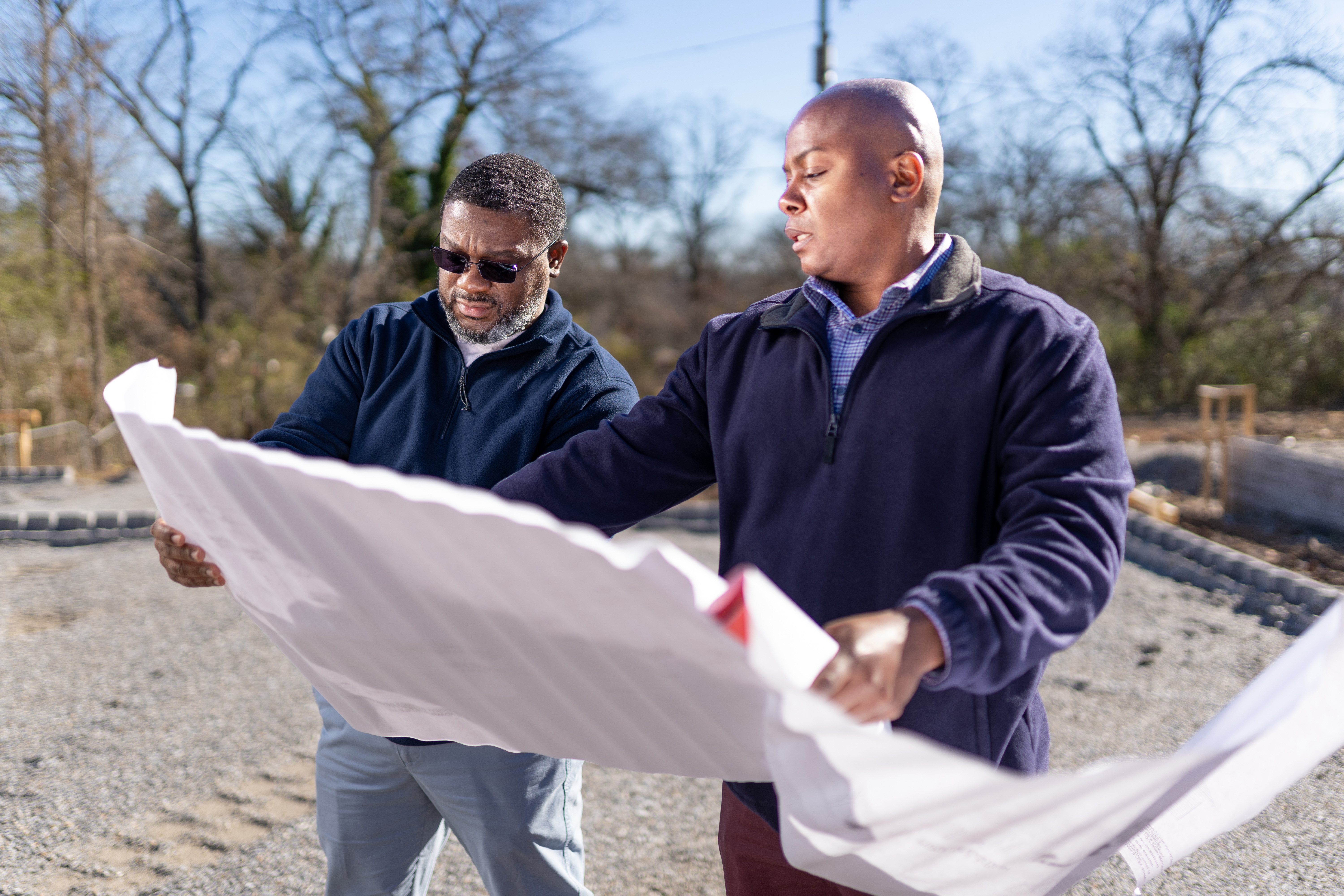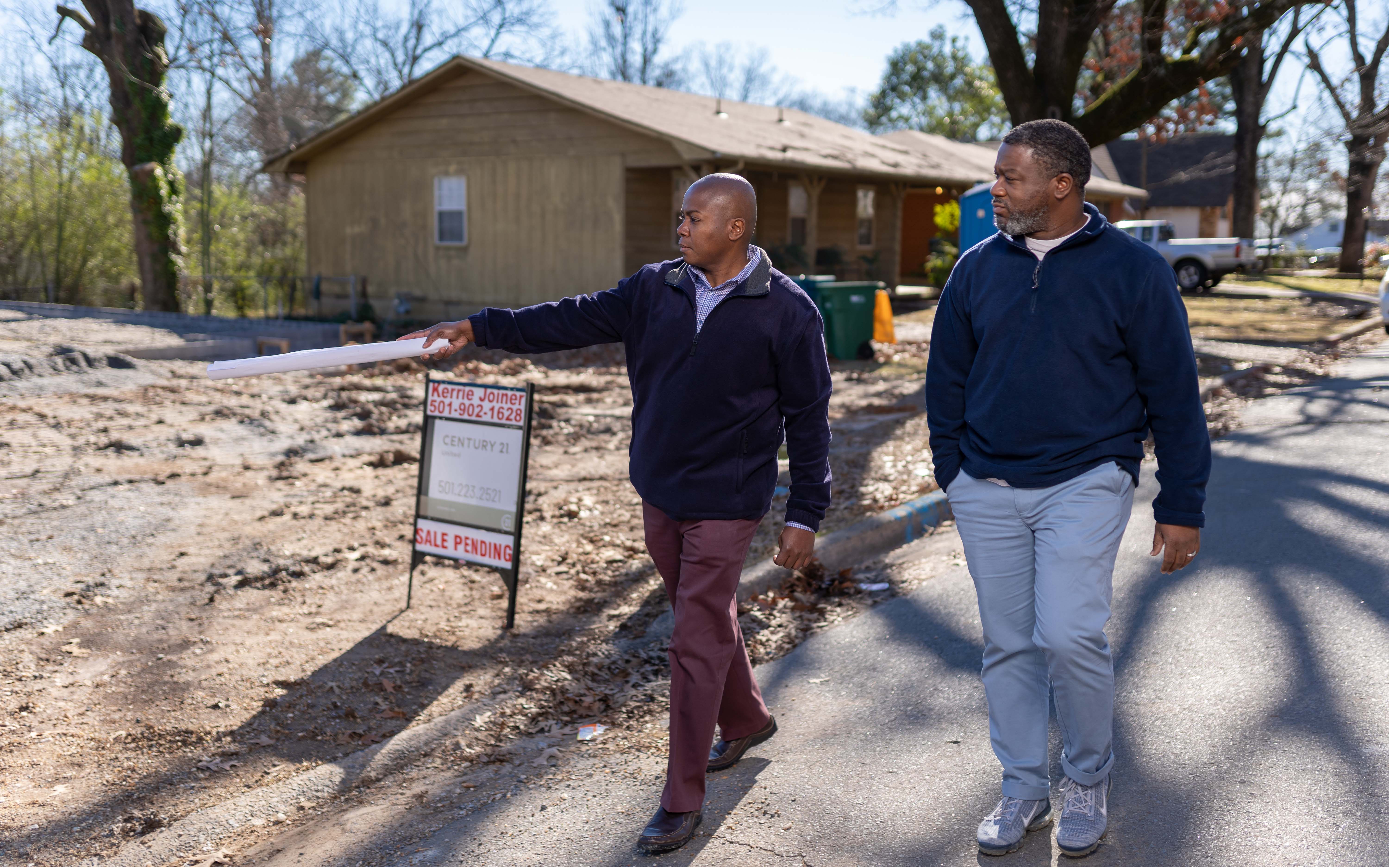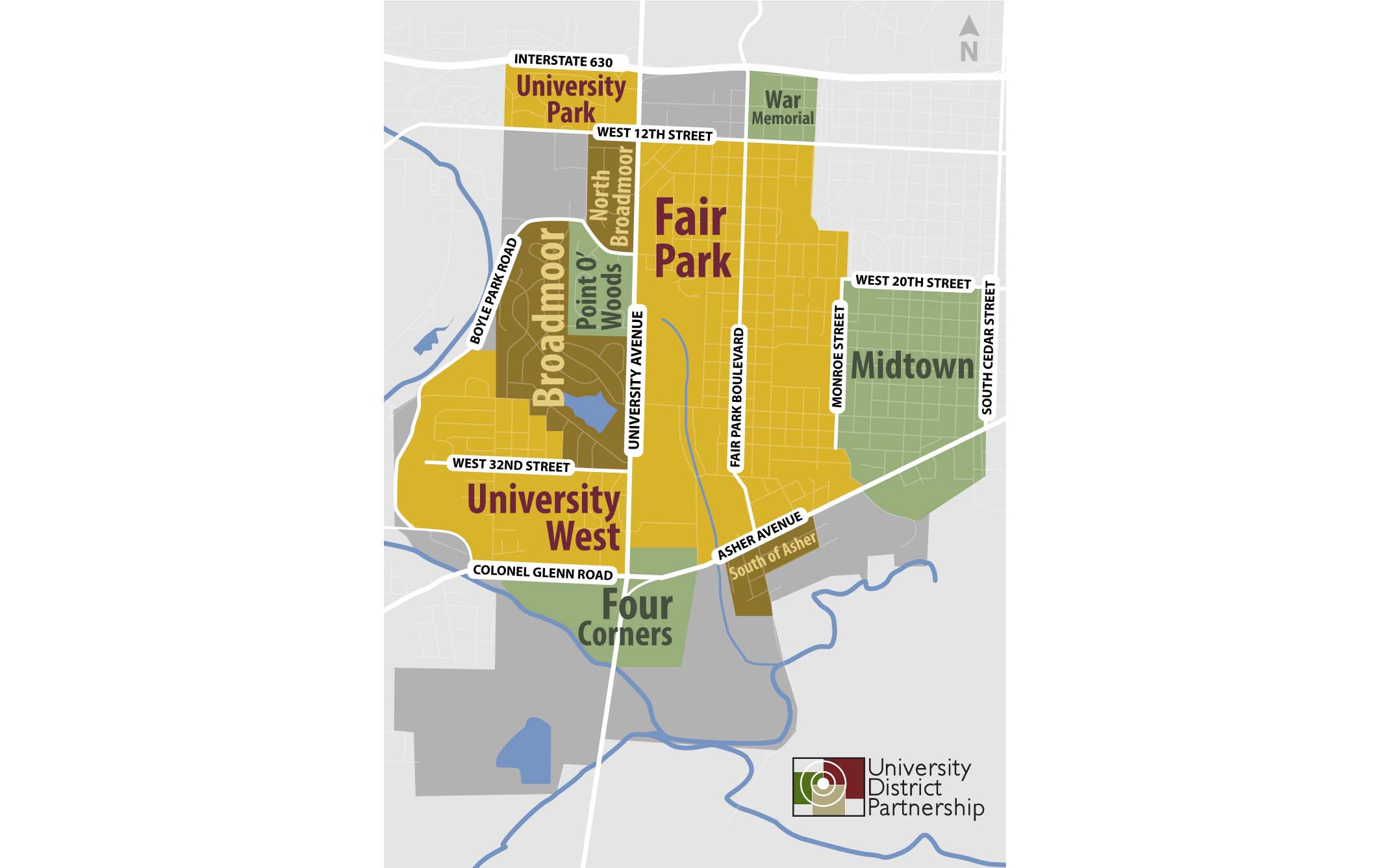University District partnership reimagining aging neighborhoods surrounding UA Little Rock
January 17-23, 2022
By Chloe McGehee
A local housing development partnership on the campus of UA Little Rock has been working overtime since 2008 to revitalize several of the city’s most “melting pot” communities.
The University District Development Corporation (UDDC) serves the neighborhoods of Broadmoor, Fair Park, North Broadmoor, Midtown, Point O’ Woods, South of Asher, University Park, University West and War Memorial, which encompass the diverse neighborhoods around UA Little Rock.
The mission of the development group focuses on improving quality of life in the district by providing safe, decent and affordable housing, as well as prioritizing a healthy lifestyle and thriving sense of community. They do this through activities such as renovating and building housing in all nine neighborhoods, and partnering with neighborhood associations, faith-based organizations and residents to improve quality of life as well as implementing programs to promote healthy living, agency officials said.
The organization has had a long road since its inception in 2008. Originally partnering with UA Little Rock, City of Little Rock, Little Rock School District, faith-based institutions, neighborhood associations and businesses and residents of the University District, the UDDC was heavily impacted by the housing market crash of 2008. Since they were focused on housing development and had just started, UDDC Executive Director Barrett Allen said they had to work hard to survive the first few years.
“The housing and financial crisis occurred which brought everything to a screeching halt,” Allen said. “A lot of nonprofits didn’t survive, especially nonprofits that specifically focus on housing. The markets dried up. Lenders, investors became skittish. I would say that’s the major trial and what we did is we kept our heads down and we continued to drive. As a result, we were able to continue planning quietly and build out the infrastructure.
“Once the infrastructure was built out we are now able to scale up and go full scale implementation. People are starting to ask questions like ‘where did this start?’” said Allen. “We were in what I call the ‘quiet phase’ in a capital campaign. We were in a consistent quiet phase and community engagement development, but now we’ve began to secure funding and hire staff and that’s helping us out quite a bit.”
As director of the UDDC that is governed by a 15-member board of directors, Barrett’s works with University District partners to plan, develop, fund and operate housing and community improvement programs. In his role, Allen has accumulated more than 16 years of experience in government and community development and currently serves as the Community Development Corporation representative on the City of Little Rock’s Community Housing Advisory Board.
On his team, he shares the workload with University District House Development Manager Quincy Edwards. A graduate of UA Little Rock’s construction management program and owner of his own construction firm, Edwards assists Barrett in expanding the portfolio of housing stock through acquisition of land, vacant homes and available properties.
Another aspect important to the local nonprofit is the partnership with its anchor organization, UA Little Rock. The university had previously done work to revitalize the district in the 90s before UDDC was created, Allen explained. The UDDC is also located on the campus, which Allen said gives them resources from different UA Little Rock colleges such as business and social work, as well as access to records and history of the district.
“It’s working collaboratively together with all the partners to address the need to improve housing conditions, to address education in the schools, and to dispel many of those unfounded and misrepresented perceptions that are out there about the University District,” Allen said. “We’re trying to address from a comprehensive approach and not just only focusing on housing, food insecurity or our faculty, staff and students. We’re bringing it all together through a community engagement process that I would say is not paternalistic.”
“We don’t go and tell the neighborhood what is best for them. In fact, they oftentimes tell us what’s not only best for them, but how we can assist them,” Allen continued. “And that’s our goal. We’re all about true collaboration and working with them to see how we can bring about the resources of the University and the nonprofit.”
The partnership also makes UA Little Rock a better institution and helps inspire students and alumni to want to live in the community, said Allen.
“It means a lot for the campus, a lot,” Allen said. “When you’re looking at public safety issues, people generally in Little Rock have a perception of what’s happening South of [Highway] 630. I’m not trying to gloss over certain situations, but a lot of times if you look through the 15 years we’ve been tracking with LRPD and their CompStat reports, the numbers may be higher, but it’s not all violent crimes like people think. It’s no different than the crime that’s in other parts of the city. Whether it’s Downtown North of 630, or even West of the University District. What we’re focused on is trying to dispel the perception issue and get people to see the district as a destination, similar to what it was in the 70s and 80s.”
One of the main aspects of the organization is to increase homeownership and the supply of affordable housing. UDDC does this through making improvements to infrastructure, increasing business activity and expanding employment and training opportunities for residents.
The housing development nonprofit also has creative ways of saving costs while renovating and constructing homes in order to keep the housing affordable, including serving as the developer and the contractor for all projects. That allows UDDC to limit costs, make the best decisions for each property and improve communication, Allen explained.
The renovations and rebuilds make homes energy-efficient, while adding unique decorations, such as crown molding, and make the exterior of the homes match the post-World War II style of the district. This plays into their mission of creating a community where people want to live, work and visit, said Allen.
“We can build nice houses and make capital improvements all day, but that doesn’t create a sense of community; that doesn’t meet the holistic need that is out there that residents need to have met,” Allen said. “For instance, we are considered to be in a food desert. So we operate a farmer’s market to ensure that fresh produce is brought to the University District at least one day a week. We provide a Double Up Food Bucks program. Families that are utilizing the WIC program can come and procure at the market as well.”
Allen emphasized the importance they put on providing healthy living to residents of the district. This includes, for example, refurbishing the Oak Forest Community Garden, starting a summer farmer’s market, and implementing a Garden to Grill Health Awareness Class that focuses on physical and mental health.
Allen said the community garden is one of the UDDC’s prominent accomplishments. It works on a one-third system where a third of the food is donated to the community, a third is kept for the garden and garden workers, and a third is sold for profit to generate revenue for garden expenses. This allows the garden to be self-sustaining and feed the community. Although the community garden is thriving now, plans are in the works to make it more of a destination.
“We are now focusing on making the garden a destination point in the district whereby we can focus on adverse childhood experiences at the garden,” Allen said. “We saw the need for a garden manager, so that protocol for integrative type therapy can then be implemented and utilized there at the garden. We anticipate coalitions for domestic violence and other youth groups in the garden as well. And that supports our affordable housing development work as well, in terms of trying to address health.”
However, the UDDC was not left untouched by the recent hefty supply chain issues and pandemic. Allen explained that this is where being both developer and contractor for these projects is helpful.
“We delayed construction probably for about eight or nine months because the lumber prices were three times higher than when we initiated our budget,” Allen said. “There’s a shortage of workers. With everything that’s going on, the supply chain is impacting us from time to time. It’s taking anywhere from 16 to 17 weeks to get windows now. We’re fortunate that since we are the developer and the contractor, we can go ahead and order those windows in advance so that by the time the framing is complete, they’re already here, or very close to being here on-site.”
“Whereas you can’t do that if you’re building a home for a homeowner whose financing had been approved, you can order those until the day that their financing is approved. And then you have to wait 16 to 17 weeks. So, we order before construction even starts. That’s because we’re in control of the process from a developer and contractor standpoint. We found a way to adapt.”
For the future, UDDC has big plans for the district, including a comprehensive 2021-2023 housing development plan, the University Plaza development, and more health and community initiatives.
In regard to University Plaza, students and faculty were sent surveys over a semester-long process to figure out what people wanted to see. Then, the university and UDDC held focus groups of residents, the anchor institutions in the area and the neighborhood associations.
“Everybody is happy about it. Everybody is energized,” Allen said. “We’ve been at this since 07’-08’ with the initial university’s revitalization plan, but we had all those hiccups along the way. Now, something is happening. A lot of people thought we hadn’t engaged [with the community], we just kept our heads down. Now they’re realizing there’s been a lot of work that’s been taking place over the last 5-6 years, and so this stuff isn’t just happening, it took a lot of work and bringing people together to start to make it happen.”
To supply decent affordable housing for the whole University District, UDDC has a plan to create different types of housing for different needs. The Little Rock development group will implement renovated and new-construction homes to purchase, while also creating rental and lease-to-own properties.
“For us affordable housing is not just subsidized housing, it’s also market rate housing,” said Allen. “It’s housing anyone in the University District, if they’re a tenure track professor here on campus, if they are a nurse tech at UAMS or Children’s making $40,000 to $45,000 to $50,000 a year, the housing district should be able to be within reach for them. And not only should it be in reach, but it should be safe, decent and affordable. So that’s what affordable housing is to us, not just subsidized housing.”
Allen also emphasized creating a new perception of the district, one that already exists but is not recognized.
“It’s for what we call melting pot culture. We have a melting pot here in the University District, we have several different cultures,” Allen said. “The Mexican Consulate is based here, we have several types of restaurants, [and] we have different types of stores that are already destinations for people that come from all over the city to partake in. The goal is to make the area that destination where people can create memories and not only create those memories but continue to build upon them and share them with others as it relates to the revitalization of the district.”
“We’re doing away with all the unfounded perceptions about the district,” Allen continued. “That’s how we want to go about addressing that, not meeting it head on, you know, trying to dispel it, but meeting it through our programming, through our collaborative partnerships with the residents, community-based organizations, UA Little Rock, the city and so forth. What we’re doing and the way we’re going about it is bringing people together to try to accomplish this particular work, [we want it to] truly make a difference in the lives of people that live in the University District and ultimately in the City of Little Rock.”
PHOTO CAPTIONS:
1.Rising Up: University District revitalizing melting pot communities surrounding UA Little Rock -- The University District Development Corporation (UDDC) has taken a lead role in the development of low- and moderate-income housing in neighborhoods surrounding UA Little Rock. (Photos by Joseph Crew.)
2.University District Development Corp. Executive Director Barrett Allen (left) tours the construction site of a new housing development with Quincy Edwards, the local nonprofits' housing development manager.
3.A recent University District map shows the local nonprofit's service area encompasses 3.5 square miles surrounding UA Little Rock centered on University Avenue from I-630 on the north to the Fourche Creek bottoms on the South. The population of the neighborhoods in the district include approximately 11,400 people with 4,500 households, including 53% with homeowners and 44% renters.





